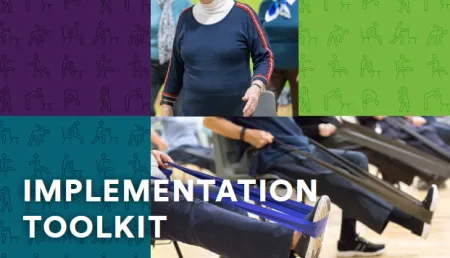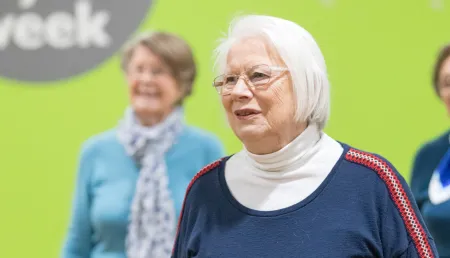
Why falls prevention matters – now more than ever
By Professor Elizabeth Orton
Falls are one of the leading causes of injury and hospital admission among older people in the UK, costing the NHS over two billion pounds each year. As our population ages, preventing falls is more urgent than ever. But who is responsible for commissioning falls prevention services? It is a simple question, but it is not a simple answer.
Who commissions falls prevention activity, and why is it so complicated?
Comprehensive falls prevention and management – as set out in the 2025 NICE guidelines – relies on a multidisciplinary approach, with input needed from physiotherapists, pharmacists, occupational therapists, ophthalmologists, audiologists, social workers, domiciliary care workers, exercise instructors, and more.
Effective support may involve medication reviews, home hazard assessments, gait assessments, progressive and tailored strength and balance exercise programmes and general advice and guidance, all provided by different organisations.
Interventions might be delivered in hospitals, care homes, hospices, in community venues or indeed one’s own home. Family and community play vital roles too.
But who pays for falls prevention? The answer is probably as varied as there are interventions available, and it is probably slightly different in every area of the UK.
Health services, which provide much of the clinical falls prevention activity are often, but not exclusively commissioned by Integrated Care Boards, Health Boards, Health and Social Care Trusts, NHS England (and devolved equivalents) and Primary Care Networks and Federations.
Leisure services, which may provide falls prevention exercise classes are a mixed economy of public sector and privately/commercially owned facilities.
Social care services that provide for example adaptations to enable people to live in their own home for as long as possible are often commissioned by local authorities or integrated health and care teams.
The commissioning landscape is truly complex.
Our research: Real-world lessons from FaME
Over the last 10 years, studies funded by the NIHR Applied Research Collaboration (ARC, previously CLAHRC) have helped implement the Falls Management Exercise (FaME) programme across the UK.
FaME is a group-based exercise programme that has been shown to reduce the risk of falls in older adults and is cost effective.
Our research shows that FaME is funded in all sorts of ways – by Integrated Care Boards, Public Health teams in local authorities, Better Care Fund (Integration) teams, local authority leisure services and by the voluntary sector. Sometimes it is funded by a combination of these organisations.
Programmes may be free of charge or cost recovered through class ‘subs’. Sometimes transport is included, sometimes not, and successful programmes often include opportunities for social interaction (“Tea and Chat”), peer support and wellbeing advice that drives sustained behaviour change.
What works: Top tips for implementation
Key lessons from our research and from talking to local leaders:
- Use evidence; Real research underpins FaME. Decision-makers need this to secure support.
- Make it a priority; Falls prevention must be a local strategic priority to gain system-level support for implementation.
- Monitor and adapt; Ongoing evaluation ensures programmes stay effective and achieve good outcomes.
- Peer and expert support; Involving experienced trainers and sharing best practice matters.
- Social connection; A post-class social element keeps people taking part and improves wellbeing.
Helping you succeed: The FaME Toolkit
Whilst it is a complex commissioning landscape, the good news is that the National FaME Implementation Team (N-FIT), together with Later Life Training, can support local sites to implement the programme.
We have also pulled together our years of learning from the research about the implementation of FaME into a FaME implementation toolkit.
In it, you can find everything you need to get started, including: a business case template that can be adapted to local context when applying for funding, a service specification when tendering for a provider, top tips and guidance on operationalising the programme locally, downloadable advertising materials, referral letter templates and data collection templates, and more.
The toolkit is evolving, and we are in the process of launching it on a dedicated website. Soon, you will be able to register online for updates and benefit from enhanced interactive support.
We really hope that our research leads to more FaME programmes being delivered across the UK so that more people can live the healthy, fall-free, and independent lives.
To download the toolkit, click here.
Further reading
If you would like to explore our research in greater depth, see the resources below:
- Factors influencing fall prevention programmes across three regions of the UK
Ventre JP, Manning F, Mahmoud A, et al. Age Ageing. 2025.
Explores challenges and key factors in implementing and spreading the FaME programme nationally.
Read the paper - Communities of Practice (CoP): A public health tool for facilitating implementation of research into practice
Orton E, Alderman V, Carpenter H, et al. 2024.
An ethnographic study of collaborative communities supporting falls prevention.
Read the paper - Mixed-methods evaluation of the FaME Programme Implementation Toolkit
Singh S, Kendrick D, Vickers R, Orton E. 2024.
Evaluates how the toolkit supports local delivery and implementation.
Read the paper - ‘It is designed for everybody to find their own level and to improve themselves’: Views of older people and instructors of the FaME programme
Gumber L, Timmons S, Coupland C, et al. Age Ageing. 2022
Perspectives on inclusivity and impact from participants and instructors.
Read the paper - ‘Real world’ effectiveness of the Falls Management Exercise (FaME) programme: an implementation study
Orton E, Audsley S, Coupland C, et al. Age and Ageing. 2021
Real-world impact data from FaME programme rollout.
Read the paper - Implementation fidelity of the Falls Management Exercise Programme
Orton E, Lafond N, Skelton DA, et al. Public Health. 2021
Analysis of programme delivery and adherence to core principles.
Read the paper - Use it or lose it: a qualitative study of the maintenance of physical activity in older adults
Maula A, LaFond N, Orton E, et al. BMC Geriatr. 2019
Explores how older adults sustain physical activity post-programme.
Read the paper - ‘We got more than we expected’: Older people’s experiences of falls-prevention exercise interventions
Lafond N, Maula A, Iliffe S, et al. Primary Health Care Research & Development. 2019
Qualitative study on participant experiences and practice implications.
Read the paper


